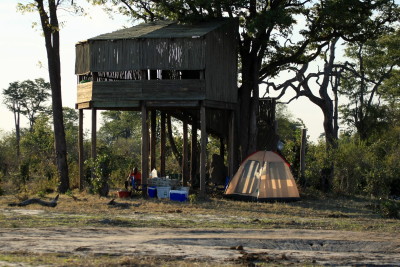Night in Nogatsaa
This week the EWB team headed out into the field to check on more environmental changes in Botswana’s elephant range. (to see where EWB works, click here) Considering time was a constraint, we decided to head to another favorite place close to home, the Nogatsaa pans in Chobe National park. Nogatsaa is approximately 80km south of the Chobe riverfront area. It is a series of natural pans and man-made artificial water holes, put into place in hopes to relieve wildlife pressure off the Chobe river, manned and monitored by the Dept. of Wildlife and National Parks (DWNP). Four of the artificial water holes also have “hides” (raised wooden platforms) in which one can quietly observe wildlife. The drive to Nogatsaa is through mixed teak woodlands with an extremely thick, sand road. Years ago, my first experience in Nogatsaa, was during the peak dry season and the pumped pans had brought thousands of elephants into the area. Needless to say, it was an experience of a lifetime to be part of such an occurrence. I am always eager to go there and see what is happening.

Poha pan hide in Nogatsaa
The drive took us several hours, bumping and plowing through the sand. We had seen very little wildlife until we spotted a lone Wildlebeest, when we arrived at the first pan, Nogatsaa pan. We saw only one bull elephant, dozing under the shade of a tree, and much to our surprise, a hippo had taken refuge in the man-made pan. Continuing on, we saw a few giraffe, sable and impala, but not much more. (EWB wildlife photo gllery, click here). We had not expected much but were slightly surprised of the lack of wildlife in the area. However, we do know from past experience that the Nogatsaa area is a place that one must sit quietly and let the wildlife come to you. The highlight of our day was at a very large natural pan, Kwikamba pan. Kwikamba had so much water that it had flooded the area and blocked the roads. In the extreme dry season, most, if not all, of Kwikamba’s water will evaporate. Yet, we discovered 6 hippos were living in this pan, over 100km from any permanent water source! The hippos were quite lively and extremely curious as we sat and enjoyed our lunch, watching them. The largest bull hippo gave a few warning yawns and came out of the water to give us quite a display of dominance. We left them in their peace.

Bull hippo, letting us know who is boss
We drove the rest of the afternoon, checking on all the other pans. None were being pumped yet, but then again, there was enough water in the natural pans that it wasn’t necessary to do so. All the roads were quite decent and they had already begun to grade the roads for easy access within the area. Only one road, access to Tcinga pan, was really terrible. During the wet season when the roads were complete mud, the elephants had obviously loved this road because they had turned it into a maze of deep footprints. We could only drive 10-15km to get through it.
We checked in with the DWNP (EWB colleagues, click here) on duty and decided to make camp at Poha pan, one with a hide. To me, there is nothing like sleeping in the fresh Africa air, without a tent. The smells and sounds are intoxicating! Sleeping in a hide allows for that, but also gives just enough protection and a feeling of security. We were having dinner in complete darkness, when we were interrupted by a single bull elephant that came to drink. Holding our breathes, no one dared to move, as we were on the ground just a stone’s throw from him. I sat with my eyes closed and listened to him drink. For every long sip, he would first make a long slow exhalation, slowly drop his trunk, take 10 seconds waving the tip over the surface of the water, breathe and then just skimming the top, take a long drawn out slurp, raised it and slowly poured it into his mouth. He drank peacefully for 20 minutes before getting his fill and moving on.
Sleeping in the hide, most of the evening it continued like that… just laying and listening to the elephants drink. Some were not as serene as the first one, and a few times, some of the elephants tussled over dominance at the pan. At one point, I woke to the sound of a leopard “sneeze” (they make a sound similar to a sneeze, announcing their presence) and could hear him walking and sniffing around below. In the morn, we woke well rested, to the sun’s rays. It was the beginning of another grand day in Botswana!
Stay posted by subscribing to EWB’s newsletter, click here
Tags: africa, artificial waterholes, botswana, conservation, DWNP, elephants, hippo, Nogatsaa, research







